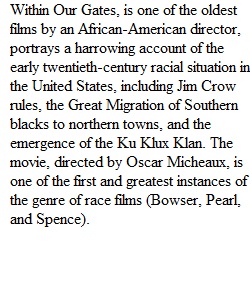


Q Black Cinema Writing Assignment #2: FRP 1 Due Date: Tuesday, January 11th. Week 2: [1/10-1/14] The Origins of Black Cinema Screening: Within Our Gates (dir. Oscar Micheaux, 1919, 80 mins) Reading: Bowser and Spence--“Within Whose Gates?: The Symbolic and Political Complexity of Racial Discourses” BB The Postwar Portrayal of the Civil Rights Era: Fifties and Sixties Screening: No Way Out (dir. Joseph Mankiewicz, 1950, 106 mins) Reading: Reid-- “IS there a Doctor in the House? Pointier in No Way Out (1950)” BB Screening: For Love of Ivy (dir. Daniel Mann, 1968, 101 mins) Reading: Bowdre--“Pointier Cinematic Intervention in for Love of Ivy, 1963.” BB Confronting Stereotypical Representations of Blacks in Cinema Screening: Ethnic Notions (dir. Marlon Riggs, 1985, 55 mins.) Reading: Bogle—” Black Beginnings: From Uncle Tom’s cabin to Birth of the Nation, Ch.1 • Diwara—” Black Spectatorship: Problems of Identification and Resistance” In Diawara, p.211-220. BB • Snead--“Images of Blacks in Black Independent Films: A Brief Survey” BB **FRP# 1 Due: T 1/11** AFRSTY122
View Related Questions